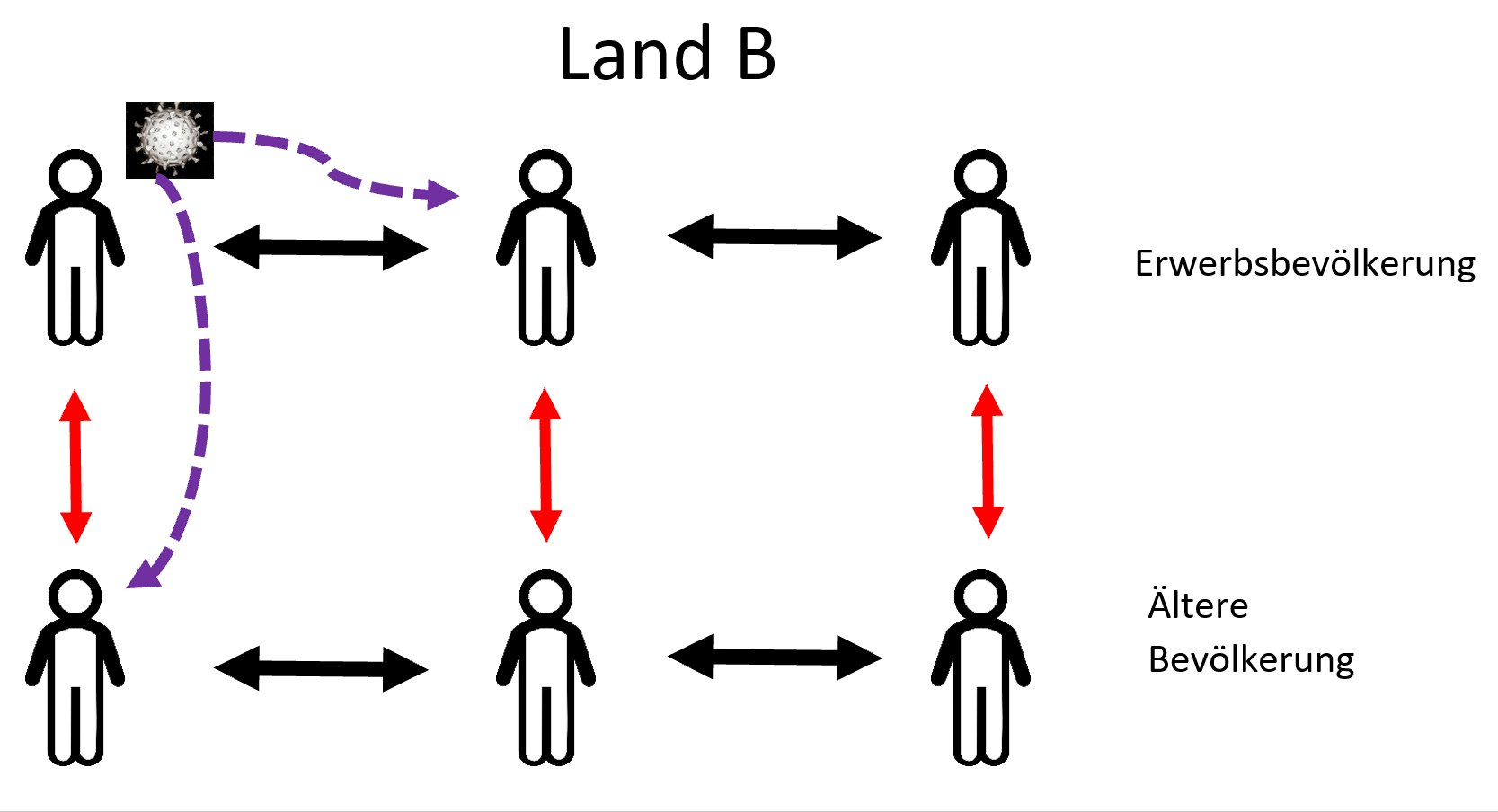When looking at Italy, the high death rates of COVID-19 infection are particularly frightening. The proportion of deaths is significantly higher in Italy than in many other countries. In Germany, the proportion of patients with fatal disease progression is still below 0.3 percent, whereas in Italy it is around six percent (as of March 15). This means that in Italy an average of 60 people die per 1,000 affected people, whereas in Germany it is three. The two economists investigated differences in the way people live together and the social interaction in different countries as a possible cause of the differing mortality rates.
Different forms of living together
In hypothetical country A, there are few contacts between the generations in daily life. The working population and older people live relatively separate lives. In country B, on the other hand, there is much everyday exchange and interaction between the generations. For example, grandparents live in the house and look after grandchildren, or younger professionals who cannot afford their own apartment have not yet moved out of their parents' house.
In order to make social contacts between generations measurable, the researchers investigated the proportion of 30 to 49-year-olds who live with their parents. There are great differences here in a European and global comparison, as is the case with the mortality rate. Researchers at the University of Bonn assume that the virus came from China to Europe mainly through the workforce and then spread here among professionals.
"If the working population is infected to a high degree, this is less dramatic for population structures like those in Germany or Scandinavia, in which we know there are fewer intergenerational contacts in daily life," explains Moritz Kuhn, Professor of Economics at the University of Bonn and in the Cluster of Excellence ECONtribute: Markets & Public Policy. "In countries like Italy, where older people often live under one roof with the whole family, the proportion of fatal outcomes increases significantly. As soon as the virus has spread among the elderly, a chain reaction occurs that overburdens the healthcare system.
Eastern European countries could be particularly affected
Not only Italy has many forms of intergenerational contacts, but also Eastern European countries. The researchers warn that these could face a situation similar to that in Italy if they delay the implementation of recommended measures to protect the elderly population, such as "social distancing". This makes it all the more important that the measures are introduced at an early stage.
Opposite trend in Asian countries
According to the researchers, the same correlation applies in principle to the Asian region, where intergenerational contacts are even more pronounced. The fact that the mortality rates are nevertheless lower is due to an overall younger population, but may also be the result of other forms of social interaction, such as different greeting rituals. It is also possible that Asian countries have become better prepared for possible pandemics and are benefiting from experience gained from the SARS crisis of 2003. For example, in many Asian countries there are fever clinics that treat only cold and flu-specific symptoms and thereby reduce the burden on the healthcare system.
ECONtribute: The only Cluster of Excellence in economics
The study was conducted within ECONtribute. It is the only Cluster of Excellence in economics that is funded by the German Research Foundation (DFG) and a joint initiative of the universities of Bonn and Cologne. The Cluster’s research focuses on markets at the interface between business, politics and society. The Cluster aims to advance a new paradigm for the analysis of market failure in light of fundamental societal, technological and economic challenges, such as increasing inequality and political polarization or global financial crises.
Study: https://selten.institute/wp-content/uploads/2020/03/ECONtribute_corona_bayer_kuhn_study_2020.pdf
Press contact:
Katrin Tholen
ECONtribute
Tel. +49 228 737808
E-mail: katrin.tholen@uni-bonn.de
Contact the author of the study:
Prof. Dr. Moritz Kuhn
Institut für Makroökonomik und Ökonometrie
Universität Bonn
Tel. +49-(0)228 7362096
E-mail: mokuhn@uni-bonn.de
Coronavirus: Why mortality varies so much Signs of life: Coronavirus - Why mortality varies so much
Study by the Cluster of Excellence ECONtribute traces high mortality rate to intergenerational contacts
The grandparents also live in the house and childcare is provided: What was long considered an ideal model for many families is dangerous during the Corona crisis: The two economists Prof. Dr. Moritz Kuhn and Prof. Dr. Christian Bayer from the University of Bonn have compared the role of social structures with mortality rates in COVID-19 infections across different countries. Result: The more working people live with their parents, the higher the proportion of Corona deaths at the beginning of the epidemic.

Country B:
- The working population and older people live under one roof. Once the virus has also spread among the elderly, a chain reaction occurs that overburdens the healthcare system.
© Moritz Kuhn
Download all images in original size
The impression in connection with the service is free, while the image specified author is mentioned.








